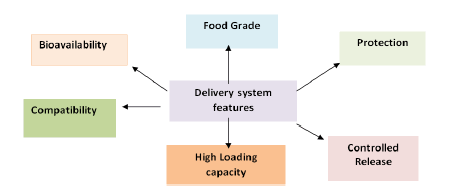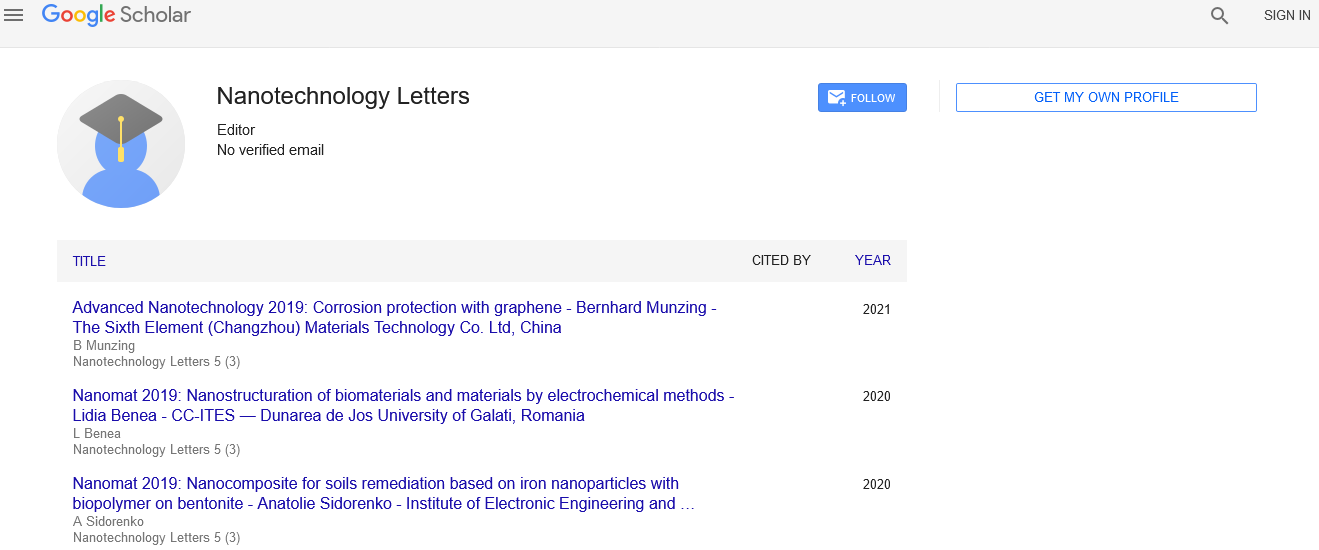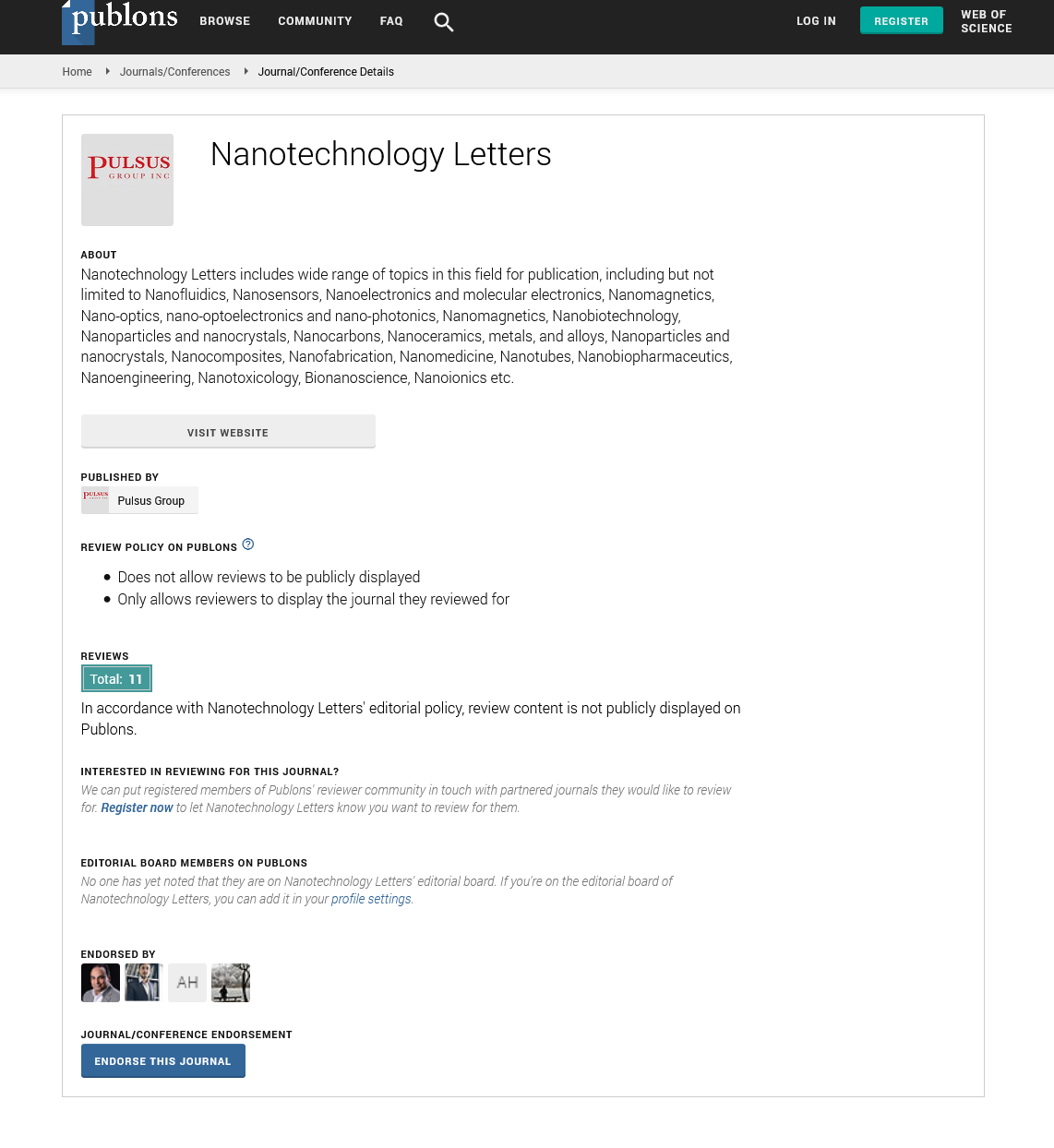Nanomaterials for herbal bioactive compound delivery
Received: 01-May-2022, Manuscript No. pulnl-22-5054; Editor assigned: 03-May-2022, Pre QC No. pulnl-22-5054(PQ); Accepted Date: May 24, 2022; Reviewed: 17-May-2022 QC No. pulnl-22-5054(Q); Revised: 19-May-2022, Manuscript No. pulnl-22-5054(R); Published: 26-May-2022, DOI: 10.37532/pulnl.22.7(3).1-3
Citation: Lockwood E. Nanomaterial for herbal bioactive compound delivery. Nanotechnol Lett.2022; 7(3):1-3
This open-access article is distributed under the terms of the Creative Commons Attribution Non-Commercial License (CC BY-NC) (http://creativecommons.org/licenses/by-nc/4.0/), which permits reuse, distribution and reproduction of the article, provided that the original work is properly cited and the reuse is restricted to noncommercial purposes. For commercial reuse, contact reprints@pulsus.com
Abstract
Nanotechnology is a multidisciplinary field that includes topics including nanomaterial’s, Nano electronics, and Nano biotechnology. Herbal medicine is an important part of traditional medicine and has been used to treat a variety of ailments. These natural treatments have been used by Asians for decades. Still, poor bioavailability, low solubility, permeability, and lack of targeting potential are all linked to the therapeutic efficacy and medicinal application of herbal extracts. Nanotechnology-based drug delivery systems that improve cellular absorption, pharmacokinetics, and effectiveness of herbal medications have made it possible to target specific compounds against diseases more effectively.
In search of long-term answers to various issues, the scientific community searches, discovers, and invents new things for the benefit of humanity. Human health is the most pressing problem among the aspects affecting human life. To promote human health, each government invests a large amount of money in research and development. The bioavailability of nutrients is the most significant component of diet, other from having the right amount of nutrients. It is wasteful to have a food item that is high in natural antioxidants but not accessible to the human body. As a result, nanotechnology has showed considerable promise in terms of improving the efficiency of bioactive component distribution to the human body.
Key Words
Nanomaterial; herbal bioactive; drug delivery; Nano carrier; Liposomes; Phytosomes; Hydrogels; Micelles; Nano emulsion
Introduction
Pharmaceutical companies have begun to manufacture nutraceuticals to treat a variety of ailments in the human body. Nutraceuticals are foods that have a rich concentration of bioactive ingredients. Bioactive substances aid in the treatment of a variety of non-communicable disorders, including cancer, diabetes, osteoporosis, arthritis, and cardiovascular disease. The effectiveness of bioactive chemicals is determined by their bio accessibility or bioavailability in the human body [1].
Liposomes, lipid vesicles, are one example of a Nano-delivery system that can include a range of bioactive substances in their core. Nanotechnology has the potential to revolutionise dietary medicine by enhancing the delivery efficiency of bioactive substances.
Nanotechnology is a new branch of science that provides solutions to a variety of challenges on a multidimensional level. Nanotechnology has aided in the development of various technological advances in food science and technology, including the construction of Nano emulsions, nanostructures, nanoparticles, and Nano-delivery systems, among others. Nanotechnology, on the other hand, is revolutionising bio sensing by enhancing the efficiency and efficacy of sensing through Nano-dimensional features of materials. The characteristics of gold particles change dramatically when their size is reduced to the Nano scale. Every study project's major goal is to provide a smooth path for humanity [2].
In this era of non-communicable diseases, such as cardiovascular disease, type II diabetes, and obesity, bioactive substances with healthpromoting effects are gaining popularity. Bioactive chemicals are thought to fight ageing, cancer, and other non-communicable diseases for better overall consumer health. In Parkinson's disease models, the Nano-phyto-bioactive substances were also investigated for their ability to alleviate oxidative stress. Bergamot flavonoids derived from citrus bergamia are used in humans as antihyperlipidimic and antihyperglycemic medicines [3].
Scientists developed the concept of encapsulation, including microencapsulation and Nano encapsulation, to improve the bioavailability of bioactive chemicals. Particles' physical, chemical, and biological behaviour changed as a result of Nano scale measurements. To successfully integrate bioactive ingredients into food systems, a structurally sophisticated encapsulation system must be designed to ensure maximum physical stability, protect ingredients from chemical degradation, and allow precise control of encapsulated component release during mastication and digestion to optimise adsorption. The Nano encapsulation system is the most modern and reliable type of delivery technology for increasing bioactive chemical bioavailability [4].
The researchers used PLGA (poly lactic co-glycolic acid polymer), micelle nanoparticles, oil in water Nano emulsions, and biopolymer nanoparticles to create Nano materials for Nano-delivery systems. The most efficient system for the delivery of bioactive chemicals is a lipidbased Nano-delivery system, which is the most efficient system in the category of delivery systems. A typical lipid-based Nano-delivery method is the liposome. Topical medications, such as creams, foams, gels, lotions, and ointments, are also delivered using liposomes [5] (Table 1).
Table 1 Nanomaterial’s for the delivery of bioactive ingredients.
| Nanomaterial | Function | Meat product | Performance in meat |
|---|---|---|---|
| PLGA nanoparticles (Phenolics loaded) | Antimicrobial | Raw and cooked meat systems | Efficient antimicrobial activity |
| Micelle (nanoparticle paprika oleoresin) | Encapsulation | Chicken breast fillet | Improved marinating performance and sensory perception |
| Oil in water Nano emulsion (Sunflower oil) | Antimicrobial | Indo-pacific king mackerel steaks | Short lived antimicrobial |
| Bio polymeric nanoparticle | Antimicrobial | Fish finger | Increased antimicrobial Activity |
Nano-delivery systems
Nanotechnology paves the way for the treatment of a variety of health issues, such as the treatment of a variety of chronic human diseases by site-specific and precise drug delivery. Liquid and solid Nano delivery systems are the two most common forms. Nano emulsions, nanopolymerosomes, and Nano liposomes are all part of the liquid Nano delivery system. Solid Nano delivery systems include polymeric nanoparticles, Nano crystals, and lipid nanoparticles, to name a few. The lipid-based delivery system is the most advanced and reliable type of Nano scale delivery system for delivering bioactive molecules, medicines, and other substances. The FDA has officially approved the first nanotechnology-based therapy using liposomes and micelles. Oils/lipids, on the other hand, are vulnerable to heat, oxidation, light, and moisture [6].
Delivery system for bioactive compounds
Nanotechnology has played an important role in the development of Nano-delivery systems. This method allows bioactive chemicals to be encapsulated and withstand the harmful effects of temperature, enzymes, and pH during food processing. For the Nano-encapsulation of bioactive substances, a variety of materials such as carbohydrate, protein, lipid, and phospholipids are used. Liposomes and Nano liposomes, also known as Nano lipid vesicles, are the most stringent and successful delivery systems [7].
Liposomes
Liposomes are spherical Nano-sized vesicles made up of one or more phospholipid bilayers that can be used to carry medications and other things. Liposomes are colloidal particles made up of lipid bilayers enclosing aqueous space that are biocompatible delivery systems for bioactive compounds, medicines, and DNA. They are biocompatible delivery systems for bioactive substances, medications, and DNA. Lipid, phospholipids, protein, and carbohydrate make up the structure of liposomes [8-9].
Liposomes have also proven to be excellent vaccine adjuvants for both cell-mediated and humoral immunity. Liposomes are similar to cell membranes in nature. This feature of liposomes made them biocompatible and safe to use in clinical settings. Liposomes have a variety of uses in food and nutrition, including the protection of sensitive bioactive substances from undesired enzymes and acids, as well as the efficient delivery of targeted molecules. Liposomes have also been used to distribute health-promoting chemicals such as enzymes and vitamins, as well as to deliver nutraceuticals and medications efficiently. The efficacy of Nano-delivery agents for the controlled and effective release of bioactive ingredients is still being improved [10] (Figure1).
Conclusion
The Nano-delivery of bioactive chemicals is briefly discussed. The report covers the basics of Nano-delivery systems, their several varieties, and liposomes as the most effective delivery mechanism. As mentioned, a number of nanomaterial’s have been used to produce nanostructures. Nano food and Nano medicine will be increasingly prevalent in the marketplace in the near future. In the near future, it is quite likely that patients will be treated using foods rather than drugs.
REFERENCES
- Salerno R, Casale F, Calandruccio C, et al. Characterization of flavonoids in Citrus bergamia (Bergamot) polyphenolic fraction by liquid chromatography–high resolution mass spectrometry (LC/HRMS). Pharma Nutr.2016; 4:S1-S7.
- Carresi C, Gliozzi M, Giancotta C, et al. Studies on the protective role of Bergamot polyphenols in doxorubicin-induced cardiotoxicity. Pharma Nutr. 2016; 4:S19-S26.
- Weiss J, Decker EA, McClements DJ, et al. Solid lipid nanoparticles as delivery systems for bioactive food components. Food biophys.2008; 3(2):146-154.
- Ravichandran M, Hettiarachchy NS, Ganesh V, et al. Enhancement of antimicrobial activities of naturally occurring phenolic compounds by nanoscale delivery against Listeria monocytogenes, Escherichia coli O157: H7 and Salmonella Typhimurium in broth and chicken meat system. J Food Saf.2011; 31(4):462-471.
- Yusop SM, O’Sullivan MG, Preu M et al. Assessment of nanoparticle paprika oleoresin on marinating performance and sensory acceptance of poultry meat. LWT-Food Sci Technol.2012;46(1):349-355. [Google Scholar] [Crossref]
- Joe MM, Chauhan PS, Bradeeba K, et al. Influence of sunflower oil based nanoemulsion (AUSN-4) on the shelf life and quality of Indo-Pacific king mackerel (Scomberomorus guttatus) steaks stored at 20 C. Food control.2012;23(2):564-570.
- Patra JK, Das G, Fraceto LF, et al. Nano based drug delivery systems: recent developments and future prospects. J. nanobiotechnology. 2018; 16(1):1-33.
- Borel T, Sabliov CM, et al. Nanodelivery of bioactive components for food applications: types of delivery systems, properties, and their effect on ADME profiles and toxicity of nanoparticles. Annu Rev food sci technol.2014; 5:197-213.
- Ferreira CD, Nunes IL, et al. Oil nanoencapsulation: development, application, and incorporation into the food market. Nanoscale res lett.2019; 14(1):1-3.
- He X, Hwang HM, et al. Nanotechnology in food science: Functionality, applicability, and safety assessment. J food drug anal. 2016; 24(4):671-681.







